#Caligari Records
Explore tagged Tumblr posts
Photo

The Holy Flesh | Herald and Adversary | 2023
UK Atmospheric Black Metal
Single release from Ritualistic & Atmospheric UK Black Metallers’ The Holy Flesh. I am usure as to whether this is an advance for a full length release or EP.. More to follow..
https://theholyflesh.bandcamp.com/album/herald-and-adversary
#The Holy Flesh#Herald and Adversary#UK Black Metal#Black Metal#Atmospheric Black Metal#Ritualistic Black Metal#Psychedelic Black Metal#music#band#Caligari Records
11 notes
·
View notes
Text
youtube



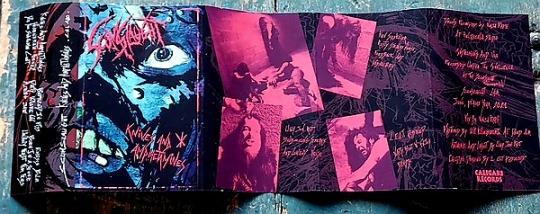



youtube


SCUMSLAUGHT
Knives And Amphetamines (2022)
Caligari Records
France 🇫🇷
#scumslaught#knives and amphetamines#2022#caligari records#france#🇫🇷#crossover#thrash metal#death thrash#Youtube#Spotify
3 notes
·
View notes
Text
Realised that Holstenwall is very much how I imagine Eskew to look






[ID: A series of photos of the sets used in the Cabinet of Dr Caligari. The architecture is at unnatural angles, and the shadows are painted on in sharp lines. End ID]
#the cabinet of dr. caligari#i am in eskew#also whilst reading the caligari wikipedia page i learnt that not all versions of the film keep the original text lettering in the. caption#is the wrong word but yknow the ones with character's speech on ANYWAY that's a shame because the letting fucks severely#theres a version on youtube with the original font (translated from german to english) and they recorded a really good score for it too
97 notes
·
View notes
Text
Caligari's Sogno Oscuro out October 6th!
https://lametta.co/caligari-sogno-oscuro-ep-lametta001/
4 notes
·
View notes
Note
I absolutely love your style and was wondering as a cinemaphile what obscure, off the wall horror movies would you suggest for the spooky season?
Uhhhh how about various levels of obscure from the 80s and 90s? (Not a complete lists because I’ve seen literally thousands of films and forget half of what I watch and use Letterboxd to keep track)
1999– Idle Hands, Don’t Look Under the Bed, Bats, Ravenous, In Dreams, Lighthouse, Stir of Echos, Audition, Kolobos
1998—The Last Broadcast, Devil in the Flesh, Whispering Corridors, Urban Legend, Shadowbuilder, The Eternal, The Quiet Family, Strangeland, Deep Rising, The Wisdom of Crocodiles, Tomie
1997– The Relic, The Ugly, Event Horizon, Cure, Wax Mask, Snow White: A Tale of Terror, Quicksilver Highway, Office Killer, The Night Flier
1996– From Dusk til Dawn, Little Witches, Uncle Sam, The Frighteners, The Dentist, Karmina, Thesis, Tromeo & Juliet,
1995– Blood & Donuts, Screamers, Tales from the Hood, The Demolitionist, Mushrooms, The Girl With the Hungry Eyes, The Day of the Beast, Serpent’s Lair, Rumpelstiltskin, Mute Witness, Evil Ed, Project: Metalbeast, Habit, The Addiction, Tales From the Crypt: Demon Knight, Lord of Illusions
1994– Tammy & the T Rex, In the Mouth of Madness, Lurking Fear, Cemetery Man, Death Machine, Brainscan, Nadja
1993– Love Bites, Doppelgänger, Necronomicon, Body Bags, Ed & His Dead Mother, Dark Waters, Skinner, Jack Be Nimble, Ticks, Carnosaur, The Temp
1992– Death Becomes Her, The Vagrant, Tale of a Vampire, The Unnameable II, Innocent Blood, Dr Giggles, Auntie Lee’s Meat Pies, Aswang, Sleepwalkers, Netherworld, Split Second
1991– The Resurrected, The Boneyard, Body Parts, Popcorn, Subspecies, There’s Nothing Out There, Highway to Hell, The Runestone, Cast a Deadly Spell, Children of the Night
1990– Frankenhooker, Fear, Nightbreed, Lisa, Mom, Grim Prairie Tales, Shakma, Pale Blood, Baby Blood, Mirror Mirror, Hardware, Meridian, Def by Temptation, The Vampire Family, Reflecting Skin, Demonia
1989– Sundown: The Vampire in Retreat, Nightlife, I Madman, Dr. Caligari, The Black Cat, Paganini Horror, Phantom of the Mall: Eric’s Revenge, The Dead Pit, The Phantom of the Opera, Dead Calm, Intruder, The House of Usher
1988– Paperhouse, Spider Labyrinth, Spell Caster, Sorority Babes in the Slime-Bowl-O-Rama, Cellar Dweller, Pin, 976-EVIL, Brain Damage, Rejuvenatrix, Blood Relations, Party Line, The Unnamable, The Wicked
1987– Psychos in Love, Blood Rage, The Caller, Stagefright, Graveyard Shift, American Gothic, Street Trash, From a Whisper to a Scream, Blood Diner
1986– Spookies, Poison for the Fairies, Vamp, Gothic, Deadtime Stories, TerrorVision, Witchboard, Trick or Treat
1985– The Doctor and the Devils, Phenomena, The Stuff
1984– Decoder, The Company of Wolves, Monster Dog, Sole Survivor, Special Effects
1983– The Lift, Wilczyca (She Wolf), Eyes of Fire, House of Long Shadows, The Hunger, Angst, Curtains, Blood Beat, Mortuary, The Keep
1982– Ferat Vampire, Next of Kin, The Sender, Tenebre, One Dark Night, The Living Dead Girl, Superstition, Alone in the Dark, Parasite
1981– The Black Cat, Fear No Evil, Dead & Buried, Possession, Night School, The Monster Club, Allison’s Birthday, Frightmare, Ghost Story, The Funhouse, The Pit, Evilspeak, Strange Behavior, The Nesting
1980– Macabre, Fade to Black, The Ninth Configuration, The Legend of Sleepy Hollow
These are all just what I’ve recorded on my personal Letterboxd since I started it in April of 2017, I’ve seen plenty more but tried to just pick possibly less-known stuff, some bad and some good.
#go ask Alice#movie questions#horror movies#movie recs#tried to skip stuff that was too… bad-taste-rapey-squicky and things shot on video
156 notes
·
View notes
Text
6 Things I Learned from the Lisa Frankenstein Commentary

We don’t get movies like Lisa Franeknstein often, which is a shame because it’s endlessly charming yet delightfully twisted. While it disappointed at the box office, it has "cult classic" written all over it.
The coming-of-age horror-comedy is out today on Blu-ray and DVD. Among the special features is an audio commentary by Zelda Williams. Here are 6 things I learned…
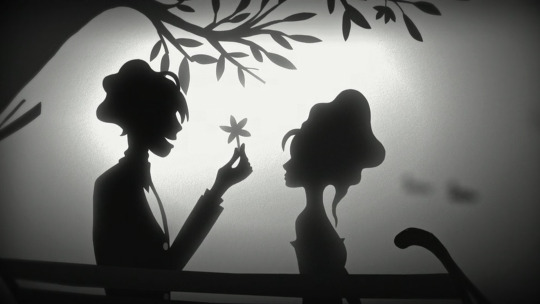
1. Catch Me If You Can inspired the opening credit sequence.
The opening credit sequence, which briefly depicts the Creature's love story from his previous life in the style of Victorian shadow box art, was inspired by Catch Me If You Can.
"We wanted to do something interesting with the credits in this bit. I was really inspired by Catch Me If You Can, which I thought the opening credits were particularly interesting and helped establish the story before we ever got to it. And because Creature doesn't speak this whole movie, I wanted an opportunity to show what his life would have been like."

2. The film was originally intended to be rated R.
Although Lisa Frankenstein pushes the PG-13 rating as far as it can go, it was originally intended to be a hard R. Williams cites the party scene, in which Lisa originally smoked a laced joint rather than drinking a PCP cocktail, as a difficult revision.
"This is where stuff got a little complicated when we were going from R-rated to PG-13. Originally there was a coated joint they were passing around. This is one of the only scenes that I'm not sure I'm as fond of in comparison to the joint stuff. Most of the rest of the changes were fine, but this one I find very strange. It's just a very different reaction and interaction than what used to be there. However, these are the things that happen when making a movie."

3. Creature is an homage to Day of the Dead's Bub.
Not only Lisa is seen watching George A. Romero's Day of the Dead in the film, but the Creature is an homage to its iconic zombie, Bub.
"Creature for me is definitely an homage to Buster Keaton, but he's also an homage to the zombie you just saw on screen, Bub, who was in Day of the Dead, a Romero movie that I'm very fond of. It was an incredibly emotive and a very intelligent zombie and ended up getting revenge against the asshole in the movie. It was one of my favorite monsters ever made, so when I could put that on screen during the movie, it made me very happy."
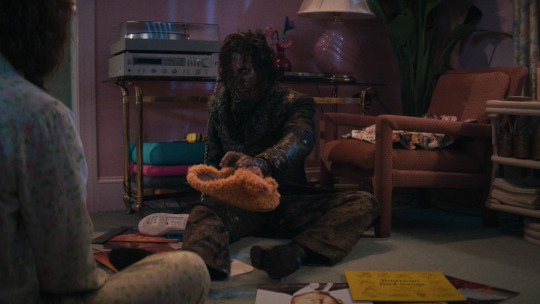
4. Zelda hid a tribute to her father, Robin Williams.
Williams is the daughter of Robin Williams, and she included his 1983 comedy album, Throbbing Python of Love, among the records scattered on the floor in Lisa's living room.
"Oh, there's Dad! We used one of Dad's vinyl albums because we had to scatter some across the floor." She refers to it as "a little, mini Easter Egg for me."
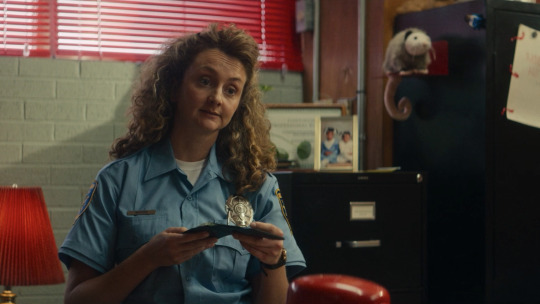
5. The police officers are named after John Waters.
The police officers in the film are Officer John (played by Walker Babington) and Officer Waters (Sylvia Grace Crim) — named on a whim in honor of cult filmmaker, John Waters.
"They asked me to name the cops, because obviously they needed to have name tags, so I named them Officer John and Officer Waters." She thought no one would notice since they're so small, but a viewer pointed it out at a test screening.
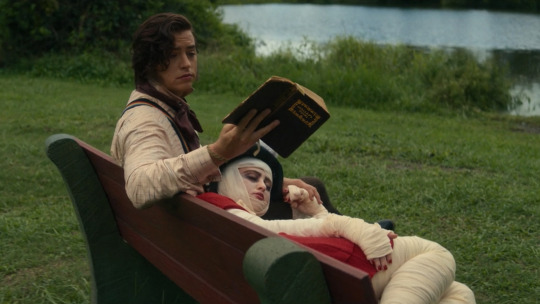
6. The film is sprinkled with movie references.
Williams wore her influences on her sleeve with her directorial debut, and she pointed out several references on the commentary:
A Trip to the Moon (clip featured in Lisa's surreal dream sequence)
The Cabinet of Dr. Caligari (stylistic inspiration on the dream sequence)
Weird Science (the party scene)
Suspiria (red lighting during drug sequence)
My Boyfriend's Back (camera shot from inside a grave looking up at characters)
Kill Bill (weapon point-of-view shot)
E.T. (a boy on a bike — played by Diablo Cody's son — at the end)
Notting Hill (reading together on a bench at the end)
Lisa Frankenstein is available now on Blu-ray, DVD, and Digital via Universal.
#lisa frankenstein#zelda williams#diablo cody#kathryn newton#cole sprouse#article#review#dvd#gift#liza soberano#henry eikenberry#joe chrest#carla gugino#horror#horror comedy
180 notes
·
View notes
Text
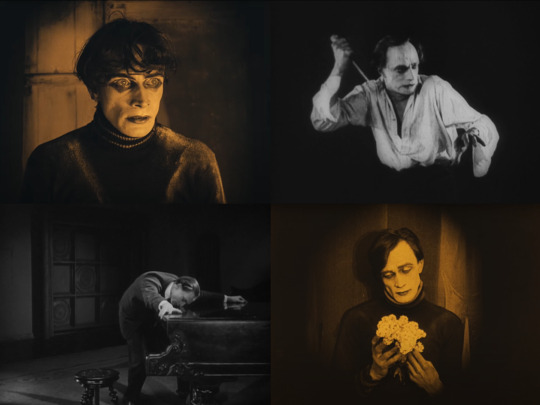
D O U B L E F E A T U R E !
The Cabinet of Dr. Caligari Dir. Robert Weine 1920 // Orlacs Hände (The Hands of Orlac) Dir. Robert Wiene 1924
I recently watched both, Caligari specifically because I was invited on a friend's podcast to talk about the film (I was totally normal about it and definitely didn't make color coded note cards about the making of the movie��� I did, I did make color coded note cards). So I figured I would lump these two in one post to switch things up.
--- Even though we talked about the movie for an hour and change, the conversation we recorded for the pod easily could have gone longer. There's so much to unpack about The Cabinet of Dr. Caligari. Between its historical, cinematic, artistic, and cultural significance and legacy, but also the various players on and off camera, not to mention the film's genesis from concept to page to screen -- there's no shortage of rabbit holes to go down.
Something I wish I had brought up during the recording was the score: The score matters! These updated silent film scores really do affect the viewer experience, and they're so often hit or miss. Of course, the original score for Caligari has been lost to time, but I read that the premier of in New York had classical music (Prokofiev, Stravinsky, etc) played along to the screening; part of me thinks this would be fun to try to recreate. I have no memory of the music when I first saw the film in 2009, but when I rewatched Caligari about a year ago, early in my Conrad Veidt journey, I chose a version on Internet Archive (which is, as of late October, sadly still out of commission *cries in nerd*) and the updated score was almost entirely minimal strings, which created a suitably eerie effect. I couldn't find that exact version elsewhere, so I this time opted for the 2014 restoration that's on Kanopy. The 2014 score is… fine. It’s very busy, trying too hard to sound like a traditional movie soundtrack. There's another version with a really painfully bad guitar-heavy score that I couldn't sit through even 5 minutes of, and still another that's entirely synths. Apparently the new 4K UHD/Blu-Ray that was just released has two new options for the score -- hopefully at least one of them doesn't totally suck!
I noticed deep into my third time viewing the film that I hadn't reached for my phone once. These days, I'll occasionally pick it up and mindlessly scroll through social media while watching a movie. But I think Caligari and a few other silent films require closer attention since they're a purely visual medium. I found myself greedily devouring every frame of Caligari. No shot or scene feels wasted. Honestly, I feel like every movie should be 90 minutes long or less. Anything longer should be turned into a miniseries. But in all seriousness, Caligari is another film I want to physically walk into. It would be pretty easy to recreate these sets, life size in grayscale black and white. The more I think about this, the more I need it. So, so bad.
I also came away this time with a lot of questions, mostly about the main part of the narrative, the story Franzis is telling. But the framing device makes the questions pointless. If the main story is just Franzis's delusion, then the absurdity of the script is totally fine I guess? Except the script that Hans Janowitz and Carl Mayer wrote didn't have Franzis as a patient at the asylum, they hated the framing story twist that was forced on their movie, so all those weird parts of the script and character choices that I'm overthinking and reading too much into are rendered meaningless. It's all in Franzis's head! The story and the characters in it don't matter! Or else are just part of his subconscious! Face palm. Eye roll.
Does the movie even work without the framing device? It would be interesting to show an edited version of the movie without the first and last scenes to someone who's never seen it. And if the twist ending was supposed to dumb down the anti-authoritarian message of the script, I don't know that it's successful. In the end, I still have empathy for Franzis. And we still have an ambiguous ending: Caligari/The Asylum Director looks at Mad Franzis and says, "I know just how to cure him," and there's a creepy iris wipe in on Werner Krauss's face that maybe leads us to think Franzis isn't as delusional as we think he is. So like… even if the whole Dr. Caligari with his sleepy twink in a box story is fake, whatever is happening at the asylum is probably just as messed up if not worse.
Speaking of the twink in a box, I love that Conrad Veidt's German Expressionism is totally different from Werner Krauss's German Expressionism. They both trained and performed with Max Reinhardt, so their foundations as theater actors in the 1910s and 1920s were likely similar. But, regardless or in spite of that shared experience, they are diametrically different human beings and that comes across in their performances in this movie. These two actors are like the textbook definition of "showing" your art vs. "being" your art. Krauss as Caligari is like "ooOOOoo look how ooky spooky and evil I am!", whereas Connie's performance as Cesare, even though it's hyper-stylized, is infused with something deeper, something primal that feels believable in the context of the film.
If Cesare has been asleep his whole life, waking only to be fed Chunky Campbell's Soup and commit murder at Caligari's bidding, then no wonder he reacts the way he does when sleeping Jane finally brings him out of his trance. When she freaks out, he freaks out too because he's had no opportunity to learn how to behave like a human or how to filter his primal emotions in a socially acceptable way. He hasn't lived his life except to be a madman's puppet. He reacts to Jane's panic on instinct and impulse, his desire and fear feel feral, like he's more creature or an animal than a human man. He may not actually want to hurt Jane, but he reacts violently because fight or flight is a basic human stress response! He runs away and eventually collapses because his body can't handle the sudden onslaught of stress and emotion he's never before experienced! And this internal, instinctual tendency to violence is subtly alluded to in the final scene when Asylum Cesare both caresses and slowly picks apart the flowers he's holding. Ahhhhh, I have so many FEELINGS.
And that said… Connie's performance here is wild, but it's real in a way that Werner Krauss's work could never be because Connie was a spiritual humanist who cared deeply for others and Krauss was an anti-semitic piece of shit who therefore could NEVER dig deep enough into his soul or into the collective unconscious the way Connie did to breathe life into his characters. So everything Krauss is doing here and in The Student of Prague is all surface, it's "showing" the audience his training and his actor toolbox rather than bringing a level of honesty and in-the-moment groundedness to these roles.
This is not to say Connie's intense commitment to his work couldn't be, uh, excessive. I really hope Lil Dagover was being serious when she said he would lurk around the studio in character when off camera. Can you imagine? You go up to the craft services table for a snack. Suddenly you feel like you're being watched. You look up and he's looming over you in the shadows, his unblinking glazed eyes boring into your soul. God, I hope this happened and I hope whoever it happened to peed themselves a little.
I also wish we had a behind the scenes photo of Connie in costume with the Cesare dummy. I can't believe someone actually had to make that prop. It'll haunt me forever. (The 1920 Cesare Dummy isn't real, the 1920 Cesare Dummy can't hurt me.)
Bottom line: It's an important film, I appreciate it for both its timelessness and timefullness. But it's not a movie I need to revisit often, regardless of how enchanting Connie's nostril acting may be.
---
The first time I watched The Hands of Orlac, I was floored by the visuals, the staging, and the heavy eroticism. Up until that point, I hadn't seen very many silent films, certainly few as visually striking. I think my initial impressions of this film were somewhat muted on a second watch, but that may just because I knew what to expect.
This time, I wasn't as swept up in the magic of silent era German Expressionist cinema, although stylistically I'm still absolutely 100% obsessed. Art direction wise, this is my favorite between the surviving Wiene-Veidt films (I haven't seen Furcht and I don’t plan to). Orlac is like the darker, sexier, more grown up sister to Caligari's mall goth teen. It's Vampira vs Lydia Deetz.
Orlac is just as much if not more of a cinematic feat than Caligari. The production design and art direction alone feels more mature and in itself tells more of a story.
Very early in the film, we're thrown into a very impressive, very realistic train crash. Opening the movie this way was a really interesting choice -- we don't get to meet the characters before the accident that starts Paul and Yvonne Orlac on their doomed and bizarre trajectory. There is a brief establishing scene of Yvonne reading a really horny letter from her husband, and one of pianist Paul at his final concert before returning home. Then there's a very long sequence of the aftermath of the train crash that almost kills Paul, and this scene brings a level of realism you don't really get in other films of this genre/done in this style. The set construction looks expensive; the mangled train cars piled up in heaps may have been fabricated in the studio, but because of the lighting in the night scene, the billowing smoke from passing locomotives and fires from the crash, it looks pretty damn real for 1924. It's extremely effective and harrowing, especially as Yvonne races to the site of the crash and climbs through the wreckage to try to find her husband. The chaos of the scene, made all the more disorienting by the movement of search lights and the haze of smoke and steam, feels true to life. People are running around, pulling bodies from the ruined train cars, carrying them away on stretchers. Survivors look around dazed, clutching their belongings in shock. It's such a well directed moment in the film, but maybe not the first thing people remember about it. And I think it's inclusion is important because it offsets how weird the movie's about to get.
And boy, does it get weird. However, the doctor does say Paul suffered a skull fracture, so it's not a huge stretch to think he also has some kind of brain injury. So I wonder if that has something to do with how the filmmakers chose to show Paul's intense fear and paranoia, as well as the movie's shift in tone and style after his accident. The nightmarishness of the film, from the exaggerated performances to the set design, feels like an extension of whatever might be going on in Paul's head as a result of his injury.
Regardless, I love the choices the art director made. The set, especially the Art Deco mausoleum the Orlacs have for a home, is so perfect. The huge, cavernous rooms are completely unnecessary, but they make the characters look and feel so helpless, like dolls in a doll house. The lines of the walls and the furnishings draw the eye through the frame with just as much intention as the painted sets of Caligari. Even places outside their house become symbolic and iconographic. The news stand is just a window cut out of a massive wall of loose sheets of newspaper that takes up the entire frame. The interior of Orlac Sr.'s house is like a old, drafty castle, looking more like the home of an evil, miserly king. The tavern where Paul is confronted by Nera feels dank and subterranean, just a lamp or two removed from literal catacombs. The outer world is fully a reflection of poor Paul Orlac's inner torment and despair and I AM LOVING EVERY MINUTE OF IT.
The new music composed by Paul Mercer is perfect, too. It's all skronky violins and cellos, ominous percussion and piano. It's just atmospheric enough, creating moments of soundscapes, echoing footsteps, aural suggestions of the oppressive cave-like rooms where the story unfolds. There aren't really any memorable themes like in the updated score for The Student of Prague, but that works for this movie. I would buy this soundtrack and actually listen to it on its own, it's that good.
Everyone in the ensemble is basically on the same page in terms of acting style, no one feels out of place or miscast. Connie of course steals the show, but Alexandra Sorina as Yvonne gives him a run for his money. She's a good match for him, delivering an appropriately desperate and hysterical (and deeply, deeply horny) performance as the touch-starved wife. Their scenes together are maybe some of the best on screen romantic moments of Connie's silent film work because these two are wildly hungry for each other. This movie is so funny, it tells you immediately how horny it is; in the first 30 seconds of the movie, Yvonne gets a letter from Paul that says, "I will feel your body beneath my hands," like they're telling you straight up this is going to Horn Town. And the way she grabs at him, presses her open mouth to him, hovers over him in his hospital bed, she is DTF anywhere any time. And no shame, no shade, good for her. This is a sex positive film, and we love to see it. But she's not just the sexy wife, she's also totally ride or die for Paul. She truly trusts him and believes his absolutely buck wild story about being blackmailed by a dead psycho killer. What a gal.
Then there's Paul, aka Eraserhead Baby… because when he wakes up from surgery covered in bandages, he looks like the Eraserhead Baby. Connie is doing some of his finest nostril acting in this role, I have to say. As always, I am fascinated by his physicality and the choices he's making with movement and gesture. When his bandages are finally removed, he reacts as though drugged, his movements slow as though underwater or in a dream. And when he confronts his surgeon after discovering the original owner of his newly transplanted hands, he holds them out and away from his body as if they were coated in something dirty or disgusting. As Paul's life and sanity unravel, his hands and fingers are in almost constant motion, curling, twitching, clutching; his body language becomes more creature-like, moving in a way that calls up Cesare the sleepwalker -- interestingly, the two characters both seemingly at the mercy of forces outside their control.
We don’t get to know what Paul was like before the accident, how much this traumatic event changed him. There's something this movie is trying to say about trauma and how it affects people. The doctor tells Paul, "Nature and a strong will can overcome anything." But if Paul sustained any kind of serious brain damage, who’s to say his personality wasn't affected, or that he wasn't fragile and suggestible to begin with? Either way, in the wake of the accident, Paul's vulnerability and circumstance makes him a perfect target for Nera's grift.
Even without being targeted by a sick weirdo con artist, it's no wonder Paul's really going through it. He tortures and punishes himself relentlessly for something that wasn't his fault! (Been there.) He puts on a recording of one of his old concerts and crumples in grief for having lost not only his livelihood but also his outlet for creative expression -- not being able to do what you used to creatively because of trauma is REAL. He's trapped in his misery. Even his handwriting is different, now a violent scrawl he imagines is due to the murderous acts his hands supposedly committed. He secretly retrieves the planted murder weapon in order to further convince himself he's somehow become evil, wielding it as through he committed the crimes of the dead man whose hands now belong to him. And the scenes where Yvonne comes to him, wanting to both devour and comfort him, he cannot bring himself to touch her. Clearly they love each other very much and their relationship was very physical, so the agony and yearning in his face when she embraces him is UGH IT'S SO GOOD. It's heartbreaking. There's a lot to unravel here about trauma, body dysmorphia, and intimacy that I'm interested to dig into during subsequent viewings.
Final thoughts: There's an annoying part of my brain that wants the movie to make sense, for the timeline to be clearer, for loose ends to be tied up. But I know that none of that really matters because this movie is better received as a dream or a nightmare. And by that logic, it doesn't have to make sense. The Expressionist beats are being hit particularly hard, but the surreal quality allows the filmmakers and cast to get away with it. For fans of Conrad Veidt, this is a must-watch, even before Caligari -- he gets more screen time in this film, gets to play with his silent film artist's palette, and gets to do pathos like he's the king of tragic, pathetic characters. He's gangly, glassy-eyed, and trembling like a small wet dog the whole time and it's superb. Despite not really getting a chance to know the Orlacs before they're thrown into their own personal hell of body horror and credit debt, they're both pretty sympathetic. From psychological commentary to the erotic visuals and tension, it's all very ahead of its time.
29 notes
·
View notes
Note
how does one go about curating a list of silent horror films with weird orchestras? i would be very interested to see any recs you may have
Uh, well, there might be a bit of a snag there. I am blessed to live in a major city, where (1) there is a movie theater focused on bringing independent, foreign and cult films to screen, and every October, they come up with a slate of horror films---including inviting an orchestra to perform their original score live during a showing of Cabinet of Doctor Caligari; and if that's the case, (2) you can do it again a few weeks later, when the local NPR station shows Nosferatu, again with a live orchestra accompaniment.
That said, I believe the Invincible Czars have recordings available for purchase on their site! They did a great job, and that would certainly be somewhere to start.
#this is why when my parents ask whether I'll ever move to the suburbs I have no response.#why. if I did not live in a city what would I do.#a proscenium for our dreams
44 notes
·
View notes
Text
Guess what I got! The recording scripts for all of the episodes of Spongebob season 13!! Gang gang
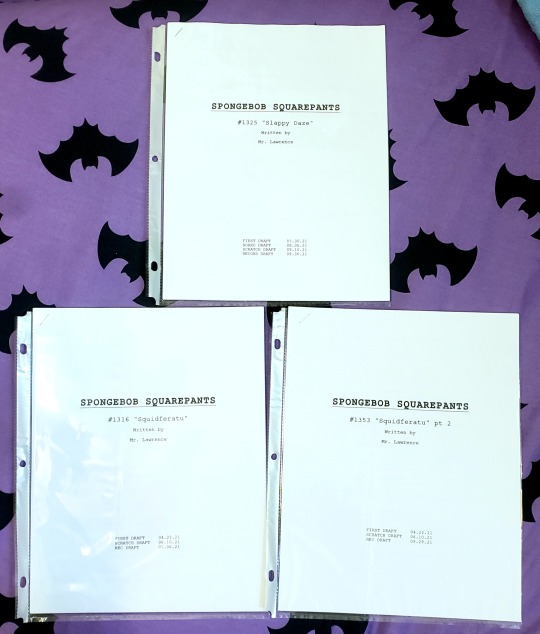
I got it from some guy from YouTube. He said this was leaked on internet archive and Nick tried to scrub it clean off the interwebz. He managed to salvage some and he gave me a link. His account was gone before I had an opportunity to say thank you, so now I have it. I'm sharing it here because idgaf if my account gets taken down lol. But also no one checks tumblr anyways.
I made sure to print out the Slappy Daze recording script because idgaf about the other episodes tbh. I only care about my beloved Peter Lorre fish's day in the limelight <3 I put it in this plastic slip and keep it in a nice binder. It's my most prized possession besides Slappy's character sheet. I also have the Squidferatu script as well.
To be honest a lot of these scripts are pretty similar to the final product of the episode. There are some minor differences like Slappy wasn't originally in the script for There Will Be Grease. Instead it was supposed to be some nerdy fish asking if everything juice will make him sound more manly. Bless whoever snuck Slappy in there because you all remember me tweaking for a week when the episode came out because I was so happy Slappy got a part in the song lol.


Also the episode Upturn Girls was originally titled City Cetaceans.
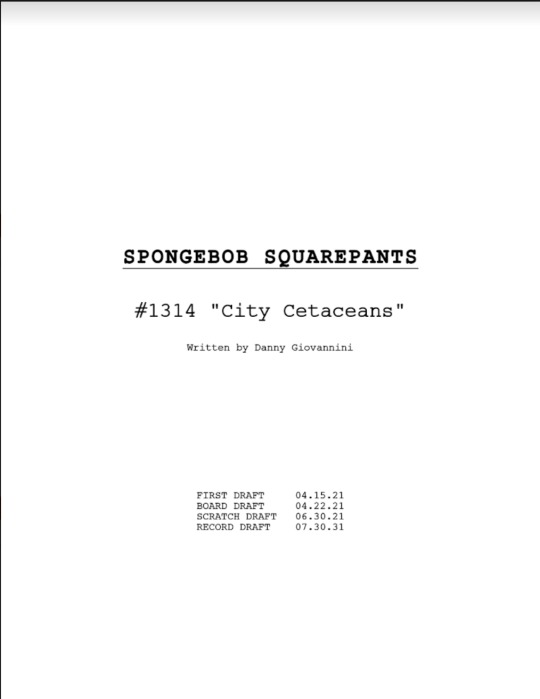
Slappy Daze is pretty near identical to the final product tbh. Nothing really changed besides a few words. I am fascinated by the fact that the first draft is dated as being July 30th 2021. By that point I already fully and completely developed Slappy brain worms and was already considering watching Lorre's movies to get my fix cuz the airings of the Patrick show were frustrating. Ahh the good ol days <3
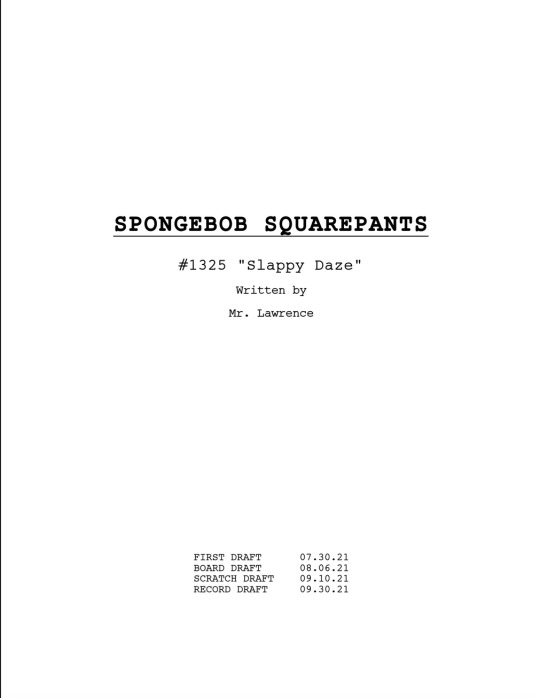
I also do believe Slippy (Slappy's female counterpart) was made for Slappy Daze originally though. The episode gives a physical description of Slippy which makes me think she just made for the moment. I think she was added to Mid-Season Finale in The Patrick Star Show episode afterwards but Mid-Season Finale aired first. Nickelodeon actually did mess up with this episode and released it on DVD before it officially aired. Now the pieces are coming together. This is only interesting to me lol.

Spongebob fans are such h8rs fr. Where else would you find THE original dreamy haired emo boy Cesare the Somnanbulist working as an assistant for the primary care physician fish Dr. Caligari? I would LOVE for Cesare to rid me of my allergies😤😤

Squidferatu actually has the most differences between the script and the final product. Plus plenty of interesting details. Squidferatu actually has two scripts, part one and part two.
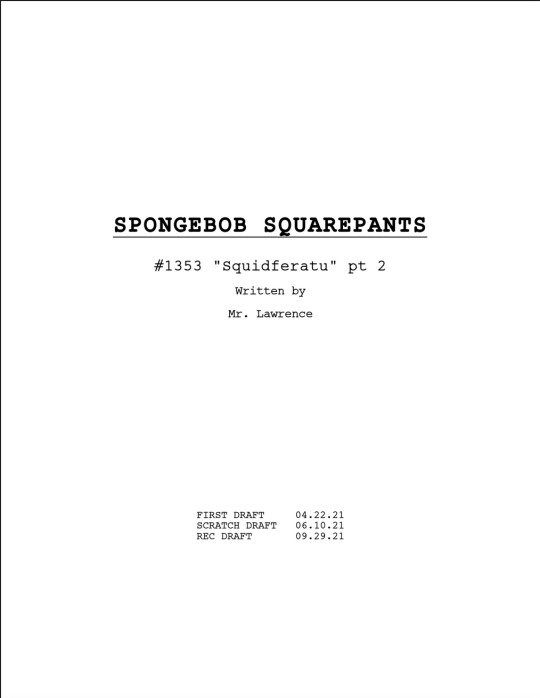

The first and most important detail to me is the fact that Slappy is still named "Laszlo". You've seen Slappy's character sheet where it mentions he was formerly named "Laszlo" (obviously a reference to Peter Lorre's birth name Laszlo Löwenstein).

But in the Squidferatu scripts you can actually find the EXACT moment where his name changes from Laszlo to Slappy. It all has to do with one specific gag.



These both are the same scene. The left side is from Squidferatu part 1 and the right is Squidferatu part 2.
I do think they absolutely fumbled the name Laszlo. There are enough cartoon characters named Slappy. Laszlo is much much cuter and brings the Lorre reference full circle but oh well.
I also keep forgetting to mention but the villager in Squidferatu who begs Spongebob and Squidward not to go to the castle was intended to be the same villager in the 1931 Dracula who warns Renfield, who actually was based on a villager from the 1922 Nosferatu who warns Thomas Hutter. This character respawned in 3 different pieces of media. I think he's the true star of this episode lol.


There is also the fact that carriage driver in Squidferatu is confirmed to be Nosferatu! I feel like this fact is obvious enough if you're familiar with Dracula media (1922 Nosferatu, 1931 Dracula, or even just reading the book) the count is always the carriage driver duh


Also the fact that in this episode he hisses like a vampire, is strangely humanoid, and briefly has the Nosferatu™ eyebrows which fully gives it away. Unfortunately the folks on the SB wiki do not agree >:((
The first time I saw the carriage driver I said "ohh he kinda bad" and you know what? I'm not retracting my statement. He IS a baddie. I'm tired of lying to myself otherwise.
Anyways this caused me to come up with a headcanon that Nosferatu is broke and likely does not pay Slappy. I mean that explains why Nos has taken on shifts at the Krusty Krab, but also explains why Slappy is working 2 jobs in The Patrick Star Show. I imagine property taxes on a castle really drains a vampire's family fortune. I'm getting off topic.
There are some extra gags that didn't make it into the episode.
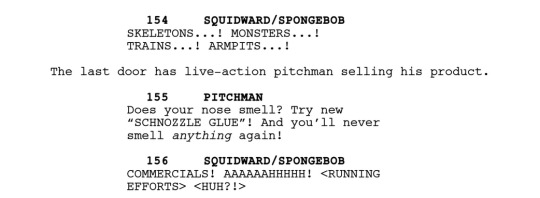
There's also the fact that we've been robbed of Erik from the Phantom of The Opera giving the audience a cute wink uwu


#the spongebob connoisseur#spongebob squarepants#spongebob#sb#spongebon squarepants#spongebob meme#slappy laszlo#slappy spongebob#laszlo spongebob#Peter lorre fish#Nosferatu#Count orlok#Graf orlok#Renfield#dracula#count dracula#robert montague renfield#the cabinet of dr caligari#cesare the somnambulist#Peter lorre#Phantom of the opera Erik
43 notes
·
View notes
Note
to take your mind of the foreboding WH movie adaptation disaster: Are there actually some non-English gothic titles you would like to recommend?
ohhhhh, what a good ask!
now, i'm actually not that well-versed in the gothic genre as i'd like to be, and if anyone has more recs they're welcome to add them to my list. but still, let's begin with:
gaston leroux, le fantôme de l'op��ra (+ andrew lloyd webber's musical - which is hugely popular, as it should be! - and i'd also recommend the 1925 silent movie with lon chaney. it's probably the most faithful film adaptation of poto... too bad for that ending tho. there's also a prequel/retelling book by susan kay called phantom, which is very good - but not flawless - except i heavily dislike christine's characterization in this one; you can always read until the counterpoint section and call it a day)
victor hugo, notre dame de paris + the musical adaptation by riccardo cocciante. it's in french, but i also enthusiastically rec the italian version - you can find both of them on yt!
so, besides these two super famous classics, there's the poem the demon by mikhail yuryevich lermontov. you can find an opera rendition of it by anton rubinstein.
speaking of opera, béla bartók's bluebeard's castle - aka a gorgeous adaptation of the fairy tale by the same name. this version is particularly excellent, and there are also a lot of good album recordings on spotify. musically-wise, tho, it's maybe not easily accessible to people who aren't already familiar with opera...?
charles gounod's faust (again, an opera!) and various non-english versions of the story, like goethe's. by goethe there's also the poem der erlkönig. here a beautiful musical rendition by franz schubert.
panna a netvor aka "the maiden and the monster", my favorite beauty&thebeast movie adaptation. it's a 1978 czechoslovak film, you can find it here on yt with eng subs. and idk if i would say it's gothic but there's also the jean cocteau 1946 film + another french one filmed in 2014 starring léa seydoux and vincent cassel.
fyodor dostoevesky, the double
carlos ruiz zafon, the shadow of the wind (which i enjoyed, but i wasn't personally crazy about, though)
it's not gothic - it's magical realism, actually - but fans of the genre would possibly like gabriel garcia marquez's one hundred years of solitude for its themes
again, not gothic (i've seen it labeled as "dark academia" but. for some people anything is ~dark academia, including dostoevesky and the picture of dorian gray, for some unfathomable reason), but i'd rec vita nostra + its sequel, assassin of reality, by ukrainian authors marina and sergey dyachenko. there's an english translation and an italian one for my mutualiani, plus a third and final book coming out in, maybe, 2025.
the cabinet of dr. caligari + the man who laughs starring conrad veidt (😳😍) - the latter is an adaptation of the victor hugo's novel by the same name
for other movie recs, the original nosferatu + dario argento's suspiria (which has also a more recent remake by luca guadagnino of challengers fame)
fosca by igino ugo tarchetti. didn't read the novel, but i watched the musical adaptation by stephen sondheim, passion, here (and that's in english). again, idt if it's gothic or even gothic-adjacent but fosca's character has been compared and contrasted as a female version of the phantom of the opera by musical theatre fans, so. here it is.
now, for things i didn't personally watch/read so i can't vouch for them, but they seem all well-written/made nonetheless and belong to my unending list(s) of books to read/films to watch:
vampire hunter d. (anime)
john ajvide lindqvist, let the right one in (novel + movie adaptation)
marina enriquez, our share of the night + things we lost in fire (novel + short stories collection)
(mind you that these recs conflate a lot with the horror department. but i still think they could be interesting for gothic fans)
two book series that are written by english authors but i think they deserve more attention:
mervyn peake, gormenghast
jonathan l. howard, johannes cabal (which contains huge references to faust, dracula, and works by poe and lovecraft. the protagonist has also become one of my favorite characters of all time, i've fallen in love with him at first... page, i guess lol)
and that's it! again, if anyone has any other good rec, please feel free to add them!
27 notes
·
View notes
Text
"Bares, qué lugares tan gratos para conversar. No hay como el calor del amor en un bar"
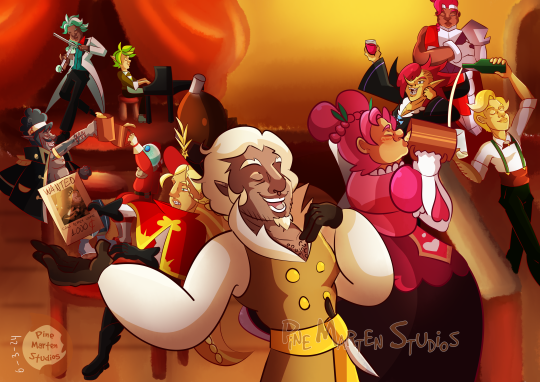
I've been working on this one for very long. I've started this canvas on February 20th, but the first actual concept for this illustration goes back to 2021, to my extremely early fandom days.
When I read Hollyberry's loading screen fact I doodled her trying to beat her glass record in Sparkling's bar, while Herb and Vamp were cheering on her and Mint Choco was playing some sick violin tunes. I proposed myself to finish that sketch one day... and I never did xd. That didn't mean I didn't forget about that doodle. The game kept evolving.
More little facts were introduced. And the bar from that tiny illustration started growing. Herb was revealed to be able to play de piano in a First Anniversary illustration, and I didn't want Mint Choco to play his violin all alone, so no they're playing music together u.u. And Cocoa went to hear Mint Choco play, of course.
Wildberry became real, so he came cuz Hollyberry dragged him. He went to the corner all alone cuz he's a bit overwhelmed by the ambient. Rye usually hits bars and orders stuff, so I thought she would be here too, probably thinking about how could she get new hints on catching Chili Pepper.
Caviar and Candy Diver are celebrating another day of hard work, and finally we have Royal Margarine, singing. And what is he singing? The song that ended helping me develop the ambient for the scene: "Al calor del amor en un bar", of Gabinete Caligari. The lyrics of the song really suit his character :0.
I wanted to challenge myself with this one. I wanted to create a scene with a lot of different characters all at once, without overwhelming the space and making everyone perfectly noticeable. And I included 11. This was pretty enjoyable to draw, both the process and the final result have been worth the time. Hope you like this one!
BTW: Here's the song https://www.youtube.com/watch?v=pUNVmH2ukwY&ab_channel=GabineteCaligari-Topic
#cookie run#cookie run ovenbreak#cookie run kingdom#hollyberry cookie#sparkling cookie#vampire cookie#wildberry cookie#cocoa cookie#mint choco cookie#herb cookie#captain caviar cookie#candy diver cookie#chili pepper cookie#rye cookie#royal margarine cookie
47 notes
·
View notes
Text
INTERVIEW
Peter Capaldi: ‘Don’t worry, I don’t suddenly think I’m a rock star’
Sun 14 Nov 2021 10.30 CET
Michael Hogan
The actor on political corruption, the genius of Terence Davies and making a solo album in his 60s
Peter Capaldi, 63, studied at Glasgow School of Art and landed his breakthrough acting role aged 24 on the film Local Hero. He’s best known for his Bafta-winning performance as spin doctor Malcolm Tucker in political satire The Thick of It and as the 12th Doctor in Doctor Who. His film roles include The Personal History of David Copperfield, The Suicide Squad and Paddington. As a director, he won an Oscar for his 1993 short film, Franz Kafka’s It’s a Wonderful Life. At art college, he was briefly in a punk band; four decades later, he is releasing his first solo album, St Christopher.
You’re releasing your debut album aged 63. How did that happen? We just set out to have some fun. My friend Dr Robert from the Blow Monkeys is a terrific musician and every year he hosts a kind of happening where disparate musicians come together for a recording session. He knew I played guitar and leaned on me to come along. It was very exciting to watch the real deal at work, so I scribbled out a song and they turned it into proper music within a day. I loved that, so with Robert’s encouragement, I had a go at writing more.
You wrote most of the songs in America, right? Yes, I was shooting the Suicide Squad film in Atlanta for four months and had a lot of downtime, so I bought a cheap electric guitar and made demos on GarageBand. I’d send them to Robert, who very sweetly rejected a whole pile of my efforts until eventually we had enough to take into the studio. We’d booked Konk Studios in Crouch End, north London, which was great because it was the Kinks’ old studio and I love Ray Davies. That was cancelled due to lockdown but we sent the demos back and forth until we had something that appeared to be an album.
Why the title St Christopher? I was always intrigued why the Catholic church got rid of Saint Christopher, who was a fabulous saint. They decided he wasn’t real but by then, it was too late because everyone liked him. The public saved him, rather like a TV talent contest. It’s a very showbiz story.
What are the album’s lyrical themes? I was in a band at art school and our obsessions back then were melancholia, punk, synthesisers, power chords, rain and being pale and interesting. I fell back into that studenty groove. Although when you’re making your first record at 63, some of rock’n’roll’s traditional subject matter is closed to you. Don’t worry, I don’t suddenly think I’m a rock star. It was just some friends doing stuff they enjoy that got a bit… elaborate.

As the Doctor alongside Pearl Mackie. Photograph: BBC/PA
Your college punk band was called the Dreamboys. That’s right, the worst possible name. We were trying for a nightmarish Kafkaesque or Dr Caligari feel, not a troupe of Chippendales-type male strippers. On drums was Craig Ferguson, who went on to become a comedian on American telly. Craig was always hilarious. A powerhouse of a drummer, too.
How successful was the band? We did OK, got our record played by John Peel and were part of a thriving scene. But after a while, we were banging our heads against a brick wall. In the old days, we’d put a song on tape, send it to a vinyl pressing plant in France, then physically take it around record shops, begging them to take a few copies. Now, technology allows anyone to put stuff out there. It’s democratised music, although it’d be nice if streaming services spread the money around.
Who are your musical influences? The usual suspects for someone of my generation: Bowie, Lou Reed, Talking Heads, Sex Pistols. At art school in 1976, we all arrived dressed as Neil Young, with long hair and army greatcoats. When the Pistols happened, we came back the next term with peroxide hair and leather trousers. OK, plastic trousers. It was only in later life that I got into Dylan and Leonard Cohen. When you’re trying to write lyrics, they’re the ones to study.
Was your Doctor Who costume partly inspired by David Bowie? Yeah, him and David Lynch, who used to do that buttoned-up white shirt thing. Another reason was I thought kids could look like the Doctor without having to spend any money. Rather than buying a costume, they could just button up their school shirt.
Your Doctor also wielded an electric guitar. Was that your idea? Between my first and second seasons, I said it’d be fun if the Doctor had a guitar to plug into the Tardis console. It was just an idea, I never dreamed it would happen. I imagined the Doctor might have invented the wah-wah pedal. We could’ve done an historical episode where he met Jimi Hendrix and introduced him to this piece of alien technology. I also thought there could be a great blues episode. When Robert Johnson meets the devil at the crossroads, the Doctor could discover something extraterrestrial going on.
What would Malcolm Tucker make of the Owen Paterson and Geoffrey Cox affairs? The whole thing is so awful, it’s beyond a joke. I wouldn’t invoke Malcolm Tucker in these circumstances. We’re in real trouble and people have to wake up to this. Actually, maybe Malcolm could shout and help wake them up to this terrible government.
Succession fans often come up to Brian Cox and ask him to tell them to fuck off. Were Thick of It fans similar? It used to happen a lot. You could say “Fuck off and get a life”, which was quite enjoyable. Sometimes they’d get me to phone up their mates and give them a bollocking. It’s great to see Brian’s success. He’s an astonishing actor.
You can sometimes hear an echo of Malcolm Tucker in Succession’s dialogue. Well, some of the writing team are Thick of It veterans. Armando Iannucci’s influence over two generations of writers and performers is immense. You can trace Succession back to him in a way.
Next up you play Siegfried Sassoon in Terence Davies’s film Benediction. What drew you to that role? Sassoon is a fascinating character and a wonderful poet but it was Terence who interested me more than anything. He’s an absolute artist who’s made some of the most amazing moments ever put on film. He’s a treasure of British cinema, a chronicler of our culture and it’s a scandal that he struggles to get finance for his not-very-expensive films. People like him should be cherished and supported.
If you had your time again, would you still be an actor? I wouldn’t change anything. I would’ve loved to be a professional musician but that would’ve also had its ups and downs, so I’m happy to be coming to it at this late stage. My life has been enormously blessed. All the side-waters and strange corners I’ve gone around have made me who I am.
St Christopher is released on 19 November by Monks Road Records. Benediction will be in cinemas early 2022.
#Observer New Review Q&A#the guardian#interview#st christopher#music#doctor who#benediction#the thick of it
7 notes
·
View notes
Text
Does anyone know where I can find a recording of the Royal New Zealand Ballet's Hansel & Gretel?
I am always down for a good fairytale ballet, and when I saw this interview with the choreographer, and he randomly dropped that the aesthetic was "early 20th century German Expressionist movie", with references to Nosferatu, Doctor Caligari or even FRIGGIN' GEORGE MELIES, I was sold:
youtube
This was an interview release for the 2023 tour of the ballet, but I know it already had a tour four years ago (according to the Youtube datation of the the RNZB videos). Anyone knows where I can get a hand on the filmed version? I only find "live streams" that of course are now unavailable...
#ballet#fairytale ballet#hansel and gretel#hansel and gretel ballet#royal new zealand ballet#Youtube
36 notes
·
View notes
Text

Můra - Needle Cathedral (EP)
Blackened Death Doom Metal from Prague, Czechia
MŮRA. The only band of its kind in the Czech music scene. This brooding death/doom metal ensemble got together in Prague in 2020 and immediately scored with all death/doom worshippers. Their successful EP "Doom Invocations and Narcotic Rituals" was released one year later on the American label Caligari Records. MŮRA will impress you with their creeping brand of doom metal, which offers a very wide overlap into old school death metal and true heinous black metal.
1. Needle Cathedral 07:12 2. Abysmal Putrefaction 05:54 3. Cascades of Skulls 08:02
Release date: January 20th, 2025 via @doomentiarecords
@muradoomband
#czechdoommetal#muradoom#deathmetal#deathdoom#deathdoommetal#doomdeathmetal#deathmetalband#doomdeath#doommetal#doommetalband#doomentiarecords#czechmetal#atmosphericdoommetal#oldschooldoommetal#blackmetal#blackdoom#blackdoommetal#doombands#melodicdoommetal#deathmetalvinyl#artwork#ep#newep#deathmetalpromotion#2025release#doommetalrelease#albumcover#bandcamp#spotify#Bandcamp
3 notes
·
View notes
Text
so I hate video editing/recording/etc but I lowkey wanna make a definitive video essay on caligari and stuff?? I work for a video essay channel and all I do is write scripts. and that's fun. but I'm also like. what if I Went Off on my own channel
4 notes
·
View notes
Note
Well! You're right, phantom of the paradise is fucking phenomenal. And! Going to think about this for the next 4 or 5 months daily. Really enjoyed the avant-garde cinematography, The contrasts were amazing. A lot of reds, pinks, whites! Expressionism through the staging is so fun. The death records logo being a dead bird, then killing swan, having Phoenix wearing live bird attire the whole time is choice (name included). Even Winslow's last name being leech is fun ( only one with integrity in the film). Also bring back movies that are an hour and 30 minutes. I feel like I got so much more out of that than any other film I've watched in recent years (contemporary).
I am so happy you enjoyed it! :) Every time I watch it I'm in awe. The whole tour of styles, both musical and film. Winslow's song being rewritten as a perfect, lacerating Beach Boys satire, the entire "Somebody Super Like You" concert performance with the puppets in the audience and the Dr. Caligari-ass stage design, I could go on and on. It's bananas. Just fucking packed to the gills with amazing ideas. Fun fact: Swan's company was originally called Swan Song but they had to change it at the last minute, as I understand it under threat of litigation from Led Zeppelin, whose vanity label at the time was called Swan Song. The production designer Jack Fisk was a high school buddy of David Lynch who went on to design Mulholland Dr, There Will Be Blood, and I think all of Terence Malick's films. A name to reckon with when you're talking about movie production design. And Paul Williams went on to collaborate with both Kermit the Frog and Daft Punk! :D
3 notes
·
View notes